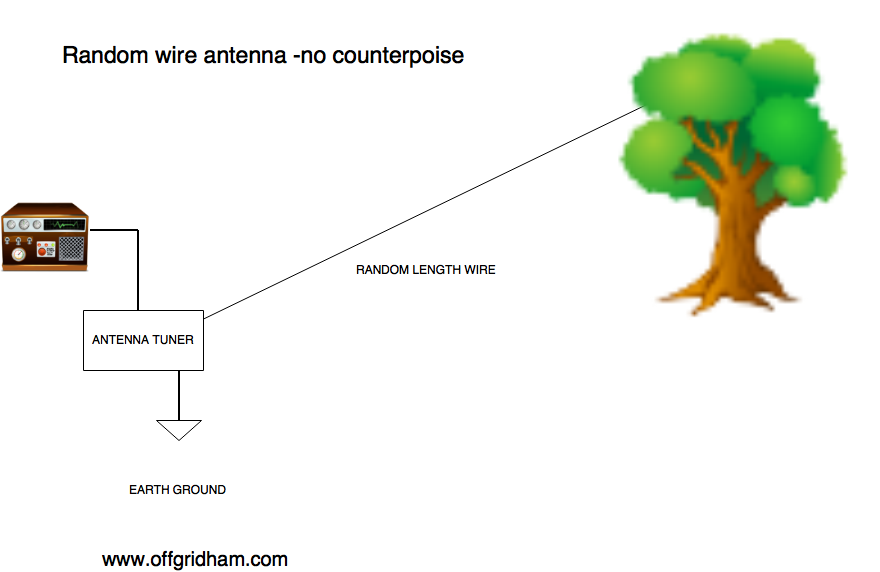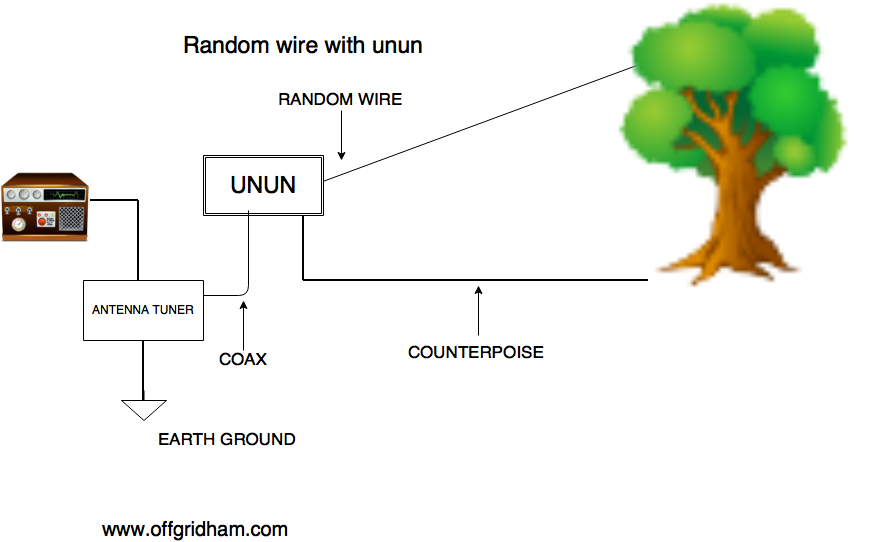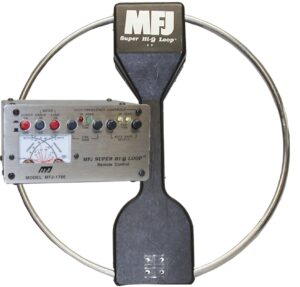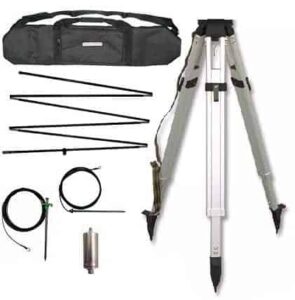We’re not special.
Off grid amateurs spend a lot of time focusing on the power source for their equipment. While that’s understandable, we musn’t be distracted from the rest of the amateur radio chain. This time we’re going to look at the other end of the system: portable antennas.
To be clear, off grid radio does not require a “special” antenna. Any antenna that can be used for conventionally-powered operating can be used for off grid. Since most off grid radio is done in a portable/temporary/outdoor setting, or for survival/prepper/EMCOMM purposes, some antennas are more suitable than others. Operators who live in apartments, have HOA restrictions, spouse objections, or otherwise cannot have a permanently mounted antenna are in this mix too. Portable Antennas
It’s not practical to go over every possible option as there are dozens of them; we’ll cover the pros and cons of a few of the most popular. If you’re a newcomer to amateur radio, you’ll gain some focus about different antenna choices. At the end of this article I will include links to more detailed information.
A word about portability. Portable Antennas
The definition of “portable” varies considerably depending on who you ask. “Portable” can mean anything from a large trailer full of equipment to a handheld radio in a shirt pocket. It’s up to each individual operator to decide what works for them. Most of the antennas described in this article are not “portable” in the sense that one could back pack all day with it (along with all their other gear). They will all fit in an average car and can be hand carried short distances.
The classic random wire.
There is hardly anything simpler, less expensive, and easier to understand than the random long wire. This antenna has been around since the beginning of radio and is still used today. They can be made from any conductive wire and erected in any fashion.
The three basic types of random wire antennas are illustrated below:
If you’re going with a random long wire antenna, you’ll need a separate antenna tuner. The integrated antenna tuners on modern radios will not likely be enough. You can try it and you might get lucky, but very few internal antenna tuners have enough range of correction to get a random wire down to the 50 ohm load the radio requires. I have an external tuner that feeds an unun with a ground plane wire for my random wire antenna; that modified setup works well plugged into my FT-817. Portable Antennas
The tradeoff for ease & simplicity is inefficiency. The antenna tuner does not “fix” this problem. Whatever losses are inherent to your random wire will still be there.
Other random wire considerations.
You’ll also have to consider that random wires are not self-supporting. How do you plan on getting your antenna off the ground? You can bring a PVC pipe or telescoping mast but lugging it along that may not fit with your definition of “portability”. Another option is to run your random wire up to a tree. That too may be problematic. Is there a suitable tree at your operating site? Be aware that many public parks in the United States prohibit attaching anything to the trees, even temporarily.
Some hams advise cutting the wire to be a certain length, or to avoid a certain length. This is done to make the antenna work better across all the bands. That’s fine, but then it’s not really a “random” wire. This may seem like semantic nitpicking but if you are going to cut a wire to a specific length you may as well take it all the way and make a proper end fed or dipole antenna. My wire antenna truly is random; I have no idea exactly how long it is. For all its faults, random wires really do work, and there’s no beating the low cost and simplicity.
The magnetic loop. Portable Antennas
The magnetic loop is one of the most beloved and hated antennas in all of hamdom. I’m not sure why, but every time it comes up in conversation, strong opinions fly back and forth.
Magnetic loop antennas are a conductive loop, a variable capacitor, and a smaller coupling loop. The loop can vary in size, with some versions having less than a three foot diameter. In spite of their small size and odd appearance, mag loops are quite effective. Magnetic loops do not require a tuner and are excellent for restricted space applications, such as apartments, motorhomes, etc. One of the big benefits of magnetic loops is they do not need to be mounted high off the ground. Any elevation greater than one loop diameter is just as good as mounting it on a 100 foot tower.
Magnetic loop disadvantages.
Mag loop antennas have narrow bandwidth. This has a lot to do with the “Q” value of the antenna, which in turn is related to the antenna’s small size, but that’s more than we’ll get into this time around. If you change your transmit frequency, even a little, the antenna will need to be re-tuned. Therefore, you will need easy physical access to the loop. There are commercially made mag loops such as the MFJ-1788 with a remote tuning head. It’s an expensive option, so consider your needs and wants carefully. Also, mag loops will have very high exposed voltages, even at low transmit power levels. Although it’s not necessarily dangerous, if you touch a mag loop while it’s energized, you’ll likely get a very memorable jolt! Keep it away from children, pets, and untrained bystanders.
If you prefer to build you own, the internet is full of plans and tips for DIY versions. By the way, the loop does not have to be a perfect circle, or even be a circle at all. Octagons and other shapes are acceptable. Portable Antennas
In my opinion, magnetic loop antennas are highly underrated. Once you learn its quirky ways it will provide excellent results.
Vertical antennas.
Commercially made portable vertical antennas might be the most popular antenna for off gridders. There are many choices: Buddistick, Alpha Antenna, Chameleon, and others. They generally do not require a tuner and will operate over numerous bands. Unlike mag loops, verticals maintain good bandwidth without constant adjustments. And unlike random wires, they do not take up much linear space when deployed. They’re easy to set up and take down and self supporting. There’s a lot to love here. I personally use an Alpha Antenna FMJ and I must say it delivers on its promises.
The main disadvantage is the cost. Commercially made portable antennas are pretty dang expensive for what you are getting. I realize a lot of the price tag is related to research & development expenses, plus the relatively low production runs of these products. Because portable antennas can be a serious financial commitment for the average operator, it’s important to do your homework and make sure you’re getting an antenna that is appropriate for your operating goals. Portable Antennas
Everything else.
There are so many other antennas that we can’t realistically go through them all here. Some of these antennas are quite effective, others not so much. Still others are just more complicated versions of well established designs. Experimenting is a big part of the fun, so don’t be afraid to take a chance. Home brew antennas are typically inexpensive and can be recycled into something else if they don’t work out.
Resources.
Here is an Off Grid Ham article from 2016 that goes into detail about random wire antennas, including notes on how to build your own.
This awesome database gives DIY plans for over four hundred antennas. It’s one of my favorite antenna resources and I highly recommend you bookmark this one.
This lengthy (33 page) PDF goes into deep detail about magnetic loop antennas, including operating theory. If you are or want to be a mag loop geek, this one’s for you!
Here’s another very well written and illustrated article about mag loops.
Here is a handy on line mag loop calculator if you want to take a stab at building your own.
The Villages Amateur Radio Club published this very well done guide to stealth antennas for those living in HOAs, apartments, etc.
Finally, an easy to understand explanation of antenna Q values.





Thanks for the article. I bookmarked the links you provided so I can browse them later.
I love fiddling with antennas, especially small ones that are easy to deploy. My favorite is the magloop. I’ve had an Alpha magloop that will work from 80M to 10M for a few years now and I love it, but yeah, it does have it’s issues. I can tune it by ear now by peaking the sound levels on the receiver and generally get pretty darned close to a low enough SWR that it will work. But it is very, very touchy as you said. But on the plus side the whole thing, including a tripod, packs easily into a backpack with my other gear and it only takes minutes to set up.
I also have a “Buddipole” type portable antenna which has been sitting out in the garage mostly unused since I bought it because it’s so awkward to work with.
I don’t get involved in arguments about antennas. My opinion is whatever you like and whatever works for you is fantastic. I’ll let the curmudgeons over on QRZ and other forums argue about that nonsense. Don’t worry about what antenna you’re using, just get on the air and have fun. 🙂
I don’t have a lot of experience with mag loops, but hams that use them seem to love them. I’ve been using the Alpha FMJ for a few years now and other than the up-front cost I have no gripes about it. I did look into the Buddipole. It is lighter and less expensive than the FMJ, but if I remember correctly and changing requires moving clip contacts on a coil, and I didn’t want to deal with that.
Yes with that style of antenna there is a coil that has to be adjusted. On mone I have to move an alligator clip on a wire to the right loop on the coil whenever I change bands. There are no indicators on mine, you have to count the loops to get the right place to clip on so I put some pain dabs of different colors on the loops so I can get to the right one when changing bands. It works, but it is awkward. I have a tripod for it but it still needs to be anchored down with guy lines or rocks or something or a light breeze will tip it over. I gave it to my son when I got the mag loop and he had no luck with it at all.
I’m a big fan of magloop type antennas. Mine is made by Alpha as well and it’s well made, very portable and I certainly can’t complain about the results I get with it. But then again I only use FT8 and JS8Call, both of which are low signal strength modes. I don’t know how well it might work with SSB.
I’m glad you’re happy with your mag loop. I’m going to have to look further into getting one myself. I’ve never tried one, but after doing this article and hearing from readers, I’m intrigued.
Mag loops have another major advantage: Their extremely narrow bandwidth mean they act like a pre-selector for the receiver. If you’re operating in an area with a lot of RFI it can keep it out of the preamp. If you’re operating one of the narrow digital modes you probably won’t need to tune at all.
You are right, I never thought of that. If an antenna will not transmit very well outside of a narrow frequency window, then it follows that it won’t receive either. So by default you’ve got a built-in noise filter. Thanks for the idea!
can i get the EM8 off my panels and put a MC4 to my unite
Hi Steve, I’m not clear on your question. What is an “EM8”? Is it a connector? I googled it and could not find anything called an “EM8” in the context of a solar panel.
If it is a connector, yes you can cut it off and replace it with an MC4, which it the standard anyway.
I hope this helps.